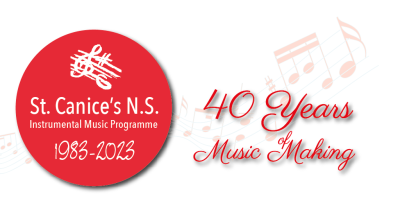The video shows Michael Rafter 5th Class 2013-2014 interviewed and performing in Senior Orchestra in the programme “Meet The Orchestra” recorded in May 2013 and aired on RTE Junior in September 2013
The French horn is a member of the brass family. As with all brass instruments, the sound is produced by buzzing the lips into a mouthpiece.
The French Horn comes in just two pieces. It is played with the left hand on top of the instrument with the first three fingers resting on the valves. Some French horns also have fourth valve for the thumb. The right hand should rest against the top portion of the bell. As students advance they will learn how to place the right hand inside the bell for a beautiful sound.
French horns are made as “single” horns or “double” horns or sometimes as a rarely seen “triple” horn. The simplest beginning horn is a single horn which can come in two sizes, either a Bb (“B” flat) or an “F” horn. Virtually all advanced students and professional players perform on a double horn.
The French horn is not as popular as other brass or woodwind instruments. Less students performing an instrument means that the competition will not be as fierce. Good French horn players are desperately needed in all beginning and advanced orchestras and bands.
The French horn is popular in bands, symphony orchestras and small instrumental groups. The instrument is also popular among Hollywood composers since they write a lot of movie music for the French horn. It also works very well as a solo instrument.
St Canice’s horn players perform in the Junior orchestra and Senior orchestra and may also get together with fellow brass, woodwind or string players to form smaller performing groups.
All instruments have limited availability and will be distributed for hire on a first come first served basis. French Horns are available for hire for two years. Lesson costs depend on the size of the group being taught and can alter annually. Please ask for further details.
